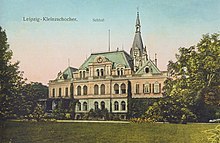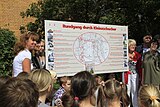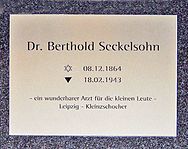Kleinzschocher
|
Kleinzschoch district of Leipzig |
|
|---|---|
| Coordinates | 51 ° 18 ′ 50 " N , 12 ° 19 ′ 20" E |
| surface | 3.04 km² |
| Residents | 10,102 (Dec. 31, 2018) |
| Population density | 3323 inhabitants / km² |
| Incorporation | 1891 |
| Post Code | 04229 |
| prefix | 0341 |
| Borough | southwest |
| Transport links | |
| railroad | Leipzig-Plagwitz-Markkleeberg-Gaschwitz |
| tram | 1, 2, 3 |
| bus | 60 |
| Source: Leipzig Lexicon; statistik.leipzig.de | |
Kleinzschocher is a district in the southwest of Leipzig and was an independent municipality until it was incorporated in 1891. The Volkspark Kleinzschocher is located on the territory of the municipality .
location
The district is located west of the White Elster , in the north it borders on Plagwitz , in the northeast and east on Schleußig , in the south on Großzschocher and in the west on Grünau .
history
Kleinzschocher emerged as a Slavic alley village in the 11th century. The starting point for settlement was the hill on which the Tabor Church stands today and which may have served as a place of worship at that time (so-called Tanzberg). In 1287 the place was first mentioned as "pavorum Scochere" (Zschocher altslaw. " Zypergras "). At that time, Kleinzschocher consisted of an upper village with a shepherd's quarter to the south of the church and a lower village to the north with a residential quarter and farms. The Hayn family was mentioned in a document in 1350 as the first owner of the manor. In 1484 the place was called Cleyne Tschocher . With the Reformation, the surrounding villages of Groß-Miltitz, Schleußig and Plagwitz were parished ( Parochie Kleinzschocher ). In 1562, 34 families lived in Kleinzschocher. In 1599 Kleinzschocher received its own school. In 1632 the village was looted and destroyed by Tilly riders . The plague raged in 1636 and 1680 . On August 26, 1703, a large fire raged in the village, which also destroyed a large part of the historical records. 26 houses, the rectory, school and manor farm fell victim to the fire. The church was saved. A great burden was placed on the population from 1706 to 1707 when Kleinzschocher was sentenced to feed the troops in the Northern War . The public pillory was abolished in 1731.

In 1742 the manor came into the possession of Chamberlain Carl Heinrich von Dieskau . When the estate was taken over, the peasant cantata composed by Johann Sebastian Bach was premiered on August 30, 1742. Two years later the place consisted of 90 houses, 52 estates, a brickyard, a sheep farm, a shepherd's house, a rectory, a church and a school. In 1812 the merchant David Johann Förster acquired Kleinzschocher Castle. In the following years he built greenhouses to promote the estate gardening and redesigned the nearby Hahnholz into a public park. The love monument was also erected.
In October 1813, the population of Kleinzschocher fled to the alluvial forest during the Battle of the Nations . Kleinzschocher, like the neighboring towns of Plagwitz and Lindenau, belonged to the Hochstift-Merseburg office of Lützen until 1815 , which had been under Electoral Saxon sovereignty since 1561 and belonged to the secondary school principality of Saxony-Merseburg between 1656/57 and 1738 . Through the resolutions of the Congress of Vienna , the western part of the Lützen district was ceded to Prussia in 1815. The exclave of Kleinzschocher, however, remained with the eastern part of the office in the Kingdom of Saxony and was incorporated into the Leipzig district office. With 134 inhabited buildings (280 family households with a total of 1242 inhabitants), Kleinzschocher was one of the largest villages near Leipzig in 1815. In 1817 Kleinzschocher housed 300 residents, 23 horses and 260 cows. The population rose to 724 by 1834. A double-headed eagle monument, inaugurated in 1913, commemorates the fighting between French and Austrian troops between Schleußig and Kleinzschocher. In 1848 the Leipzig publisher Christian Bernhard Tauchnitz became the new manor owner, who in the same year expanded the west wing of the palace and had the entire palace completely rebuilt in 1865 by Constantin Lipsius . The general gymnastics club Kleinzschocher was founded in 1849.
The situation of the working population was subject to change from 1870: While many of the residents were previously employed in bricklaying and carpentry, the majority now worked in the textile and metal factories of Plagwitz . In 1877, the important people's hygienist and co-founder of the Dresden Hygiene Museum Arthur Luerssen was born here. In the same year the windmill, which is located on today's Gießerplatz , was demolished and replaced by a new stone windmill. In 1879 an agency of the Deutsche Reichspost opened in Kleinzschocher. Since this did not have a telegraph, Kleinzschocher had to be informed in an emergency by Plagwitz or Großzschocher . The Körner pharmacy was opened by Paul Wild in 1886 and is still in operation today. Although the pharmacy was rebuilt several times, some of the original's Art Nouveau furnishings with the Offizin survived. In 1888 Rudolph Sack opened an agricultural research station on the Kleinzschochern fields, and after 1945 the Kleinzschocher estate was located there. Today the site is part of the Grünau development area.
On January 1, 1891, the place was incorporated into Leipzig , five years later the district was connected to the LVB tram network . In 1892 the first gymnastics and sports festival of Leipzig workers' sports took place. In addition, the Kleinzschocher cemetery was opened in the same year. Pastor Gottfried Christian Lohse (1854–1906) led the first funeral. Richard Lucht built the chapel in the neo-Romanesque style . Due to the prevailing housing shortage, the development of building land and intensive housing construction began after the incorporation (especially Meyer houses from 1908). From 1902 to 1904 the neo-Romanesque Tabor Church was built according to plans by Arwed Roßbach . It is the only two-tower church in the Leipzig city area. In 1905 the old village church in the immediate vicinity of the Tabor Church was demolished.
On January 1, 1909, the 140 hectare manor district of Kleinzschocher was incorporated into Leipzig. From 1910 to 1913 a landscape park was designed for the industrialist Rudolph Sack (Robert Koch Park). After the First World War , the city acquired the manor and sold the fields belonging to it. Numerous residential buildings were subsequently built on them. In 1928, the Art Deco style cinema in Schauburg was opened.
At the beginning of the Second World War , a war and refugee camp was set up in Kleinzschocher. In addition to the 49th elementary school, the castle also fell victim to the hail of bombs in the air raids.
In 1992, around 9,600 people lived in Kleinzschocher. In September 1994 it was decided to make Kleinzschocher a redevelopment area . It was an area of urban development in the west of Leipzig as part of the URBAN II funding program . Particularly noteworthy are the redesign of the industrial wasteland Rolf-Axen-Straße, the upgrading and redesign of path connections and public open spaces in the Kantatenweg area and the redesign of the southern entrance area of the Kleinzschocher Park.
Since 2008, after the old public swimming pool was demolished, the new “Sportbad an der Elster” has been in existence. The range of services and the size of the swimming pool distinguish it from the other swimming pools in the city.
For the time being, the exterior of the Leonhardsche Villa shines in new splendor. The builder was so enthusiastic about the villas on the beach of Monte Carlo that he built a copy in Kleinzschocher in 1903.
For the Jewish doctor Berthold Seckelsohn who died in the Theresienstadt concentration camp, a stumbling block was set in front of his former practice at 10 Dieskaustraße in 2010 . In the following year a plaque was put up in the Theresienstadt columbarium .
At the Adler, an important intersection that owes its name to a golden eagle at a former restaurant, a board provides information about a possible tour of the district. The individual tour stations are also listed in a flyer (see Commons).
The traditional Alfred-Rosch-Kampfbahn , a cycling track , is located in Kleinzschocher .
education
In Kleinzschocher there is the Johannes-Kepler-Schule (secondary school of the city of Leipzig), the Fritz-Gietzelt-Schule (special needs school), the Schule-am-Adler (secondary school) and the private LSOD Leipzig School of Design (preparatory course) in the old one Commercial school . The former 55th school in Ratzelstrasse is to be reactivated as a secondary school for the city of Leipzig by August 2017. By 2020, a new 4-class primary school with a three-field hall and sports field is to be built on the parking area at the corner of Rolf-Axen-Strasse and Baumannstrasse for around 16 million euros.
traffic
The line 3 tram connects the district with the center, 1 and 2 also affect the lines of the district in the west and north. There is also a connection to the important Leipzig bus route 60.
The Leipzig-Kleinzschocher train stop was on the Leipzig-Plagwitz-Markkleeberg-Gaschwitz railway line, which is not currently used by passengers .
Sons and daughters of the place
- Karl Enders (1892–1938), communist and resistance fighter against National Socialism
- Kurt Kresse (1904–1945), worker and resistance fighter against National Socialism
- Albert Hennig (1907–1998), artist from the Bauhaus tradition
- Walter Kresse (1910–2001), Lord Mayor of Leipzig (1959–1970)
- Manfred Uhlig (1927–2019), actor, cabaret artist, and television and radio presenter
literature
in order of appearance
- Friedrich Popelka: From the chronicle of Leipzig-Kleinzschocher - From Sorbendorf to the metropolitan area . Self-published for school use, 1935.
- Council of the City District Leipzig-Southwest: Leipzig-Southwest . Large graphic company Leipzig, Leipzig 1989.
- Bernd Rüdiger, Harald Kirschner: Kleinzschocher: A historical and urban study. Pro Leipzig, Leipzig 1995.
- In the Leipzig Elsterland. From Plagwitz to Hartmannsdorf . Pro Leipzig 1997, ISBN 3-9805368-3-1 .
- Burkhard Otto, Ruth Teubner, Annelis Tienelt, Ilse Uhlrich, interest group "Book Kleinzschocher": District history of Kleinzschocher . Leipzig 2007.
- Burkhard Otto, Ruth Teubner, Annelis Tienelt, Ilse Uhlrich, Interest Group "Buch Kleinzschocher": History and stories from the Leipzig district of Kleinzschocher, Part II . Leipzig 2009, ISBN 978-3-00-028481-6 .
- Christine Arendt: My Kleinzschocher . Pro Leipzig, Leipzig 2010, ISBN 978-3-936508-63-5 .
- Christine Arendt, Thomas Nabert: Kleinzschocher - A district on old postcards . Pro Leipzig, Leipzig 2011, ISBN 978-3-936508-74-1 .
- Andrea Lorz: Biographical Fragments by Dr. med. Berthold Seckelsohn. Ärzteblatt Sachsen 11/2013 (PDF; 133 kB).
- Christine Arendt: Our Kleinzschocher - images of life and traditions . Pro Leipzig, Leipzig 2019, ISBN 978-3-945027-36-3 .
- Anne Tienelt, Sabine Otto: A walk through the green heart of Kleinzschocher - From the manor to the people's park , Otto Stempel & Druck, Leipzig 2019, ISBN 978-3-00-064239-5 .
See also
Web links
- Kleinzschocher in the Digital Historical Directory of Saxony
- Information website My district of the city of Leipzig for Kleinzschocher
- District in the Leipzig Lexicon
- Stumbling blocks of Leipzig
- School at the eagle
- Johannes Kepler School
- Fritz Gietzelt School
- Kleinzschocher citizens' initiative
- »Nazi Kiez« vs. cosmopolitan Leipzig , article Kreuzer , Leipzig, February 2019
Individual evidence
- ^ Karlheinz Blaschke , Uwe Ulrich Jäschke : Kursächsischer Ämteratlas , Leipzig 2009, ISBN 978-3-937386-14-0 , p. 84 f.
- ↑ Kleinzschocher: Former 55th school in Ratzelstrasse is to be reactivated.
- ↑ Public invitation to tender in 2015 New construction of a 4-speed primary school with a school sports hall in Leipzig Kleinzschocher at the Rolf-Axen-Straße location, award of the services for property planning according to §34 HOAI and structural planning according to §51 HOAI. 2015-12-24. Retrieved December 14, 2017 .
















